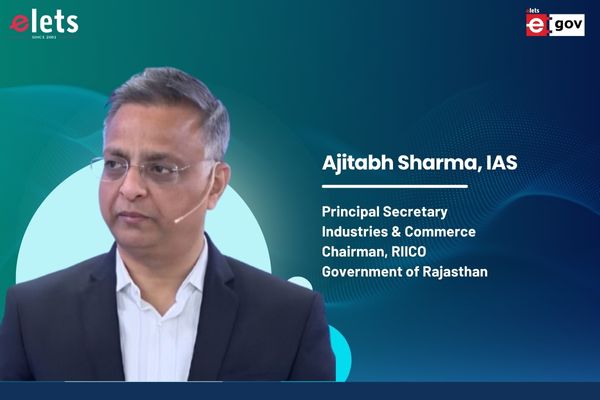
From promoting renewable energy adoption across the state to tackling pressing issues such as stubble burning and fostering energy conservation, Haryana is spearheading concrete initiatives on all fronts. Shri S. Narayanan, Director General – Haryana Renewable Energy Development Agency (HAREDA), shared these insights in an exclusive interview with Priya Yadav, Associate Editor at Elets News Network (ENN). Edited excerpts:
How has Haryana been promoting renewable energy, particularly solar energy, and what initiatives has the government undertaken in this regard?

Haryana has been actively promoting renewable energy, focusing on solar energy, to meet its energy needs and reduce its carbon footprint. The state boasts a total installed and contracted capacity of approximately 14,026 MW, with renewable sources contributing about 2,157 MW, constituting 15.4% of its energy mix. Notably, Haryana exhibits one of India’s highest per capita energy consumption rates, standing at 2,167 units annually, a marker of its developed status.

Capitalizing on its agricultural landscape, Haryana recognizes the potential of solar energy and biomass. The state’s Solar Policy 2016 emphasizes deploying megawatt- scale and rooftop solar systems alongside off-grid solar applications. Haryana has an installed solar capacity of 1,323.61 MW, comprising
265.80 MW from ground-mounted solar, 486.23 MW from rooftop solar, and 572 MW from off-grid solar installations.

The state government has launched initiatives like the Pradhan Mantri Kisan Urja Suraksha evam Utthaan Mahabhiyan (PMKUSUM) scheme to bolster solar energy adoption in the agricultural sector. This scheme offers 75% subsidies, including 30% from the Government of India, for solar pumps ranging from 3 H.P. to 10 H.P. Over the past three years, around 80,000 solar pumps have been installed in Haryana under this scheme, totaling approximately 546 MW of installed solar capacity. Haryana is the top-performing state in this national program, showcasing its commitment to renewable energy adoption and sustainability.

Additionally, Haryana has tapped into its hydroelectric potential by establishing projects with a capacity of 73.2 MW on the Yamuna barrage and its associated canal. Moreover, aligning with national environmental objectives, the government is committed to the Panchamrut Goals outlined by the Prime Minister at the Glasgow Conference, actively promoting renewable energy initiatives. Notably, Haryana Power Utilities have met their Renewable Purchase Obligations (RPO) for 2022-23 and have secured tie-ups to fulfill the targeted RPO of 43.33% by 2029-30, demonstrating proactive measures towards sustainable energy practices.
What initiatives has the State Government of Haryana taken to address agricultural waste?
The State Government of Haryana has initiated several measures to address agricultural waste. Firstly, it has decided to procure 800 MW Round the Clock (RTC) renewable energy power through tendering by Solar Energy Corporation of India (SECI) at a ceiling tariff of Rs. 4.60 per unit, with 1200 MW solar projects to be installed in Haryana. Secondly, Indian Oil Corporation Limited (IOCL) has installed a 100 KLPD capacity paddy straw-based 2G ethanol plant in Baholi, Panipat. Thirdly, Oil Marketing Companies have issued Letters of Intent (LoIs) to 165 firms for setting up Compressed Biogas (CBG) projects of 1268 TPD capacity in Haryana under the SATAT scheme, with 6 projects commissioned and 6 under execution. Additionally, the State Government has fixed Common Determined Rates for procurement of paddy crop residue and is offering Panchayat Land for biomass and solar projects at favorable lease rates.
How does the State Government of Haryana address the issue of stubble burning in the region?
The State Government of Haryana has taken multifaceted approaches to tackle stubble burning and promote renewable energy within the region. Firstly, acknowledging the substantial biomass generated annually, particularly from farm operations like paddy straw, the government introduced the Haryana Bio-energy Policy 2018. This policy aims to leverage biomass as an energy source, providing an additional income stream for farmers while creating rural employment opportunities. To address the issue of stubble burning directly, the government has approved and implemented stubble-based biomass projects across various districts, totaling 49.8 MW capacity, with operational projects in Kaithal, Kurukshetra, and plans in the final stages for projects in Fatehabad and Jind.
What initiatives has the Haryana State Government undertaken to promote energy conservation and the adoption of electric vehicles?
The Haryana State Government has implemented multifaceted strategies to enhance energy conservation and facilitate the transition to electric vehicles (EVs). Recognized for its proactive approach, Haryana secured the Second Best State award in the large States category during the National Energy Conservation Day 2023, commended by the Hon’ble President of India. Demonstrating commitment, Haryana ranks high in the State Energy Efficiency Index and strives for net zero through various energy efficiency initiatives spanning buildings, industries, transport, urban local bodies, and the energy sector.
The government encourages solar system installations in public buildings, solar street lights in rural areas, and solar home lighting systems for marginalized communities to promote renewable energy. Furthermore, the State’s Electric Vehicle Policy 2022 incentivizes the adoption of EVs, offering financial support ranging from manufacturing to purchasing stages. With over 375 operational public EV charging stations, Haryana has created infrastructure conducive to electric vehicle usage, contributing significantly to environmental sustainability and energy conservation efforts.
What are the key initiatives taken by the Haryana government to promote green hydrogen, and how do they contribute to India’s larger sustainable development goal?
The Haryana government has embarked on several crucial initiatives to bolster the adoption of green hydrogen within the state, aligning with India’s broader vision of sustainable development. These initiatives reflect a proactive approach towards reducing carbon emissions and fostering self-reliant economic pathways.
Also Read | Harnessing Renewable Energy for Sustainable Development in Haryana
Firstly, Haryana has undertaken an “Opportunity assessment” and is formulating a State Green Hydrogen Policy, indicating a strategic intent to leverage renewable energy sources for hydrogen production. Establishing two hydrogen refueling stations and installing a 7-kilo per day green hydrogen plant at Jindal Steel are tangible steps towards infrastructure development.
Moreover, the proposed hydrogen fuel-based train prototype on the Jind-Sonepat route by the Indian Railways underscores a commitment to sustainable transport solutions.
This innovation reduces carbon impact and positions India as a pioneer in green transportation.
Furthermore, collaborations with industry players like Maruti Suzuki India Ltd to facilitate green hydrogen plants within their manufacturing units highlight public-private partnerships driving environmental sustainability. These concerted efforts signify Haryana’s proactive role in fostering a green energy ecosystem while contributing to India’s national agenda of transitioning towards renewable energy and reducing carbon emissions.
Be a part of Elets Collaborative Initiatives. Join Us for Upcoming Events and explore business opportunities. Like us on Facebook , connect with us on LinkedIn and follow us on Twitter, Instagram.
"Exciting news! Elets technomedia is now on WhatsApp Channels Subscribe today by clicking the link and stay updated with the latest insights!" Click here!













